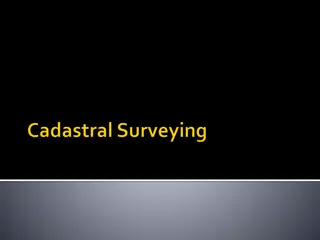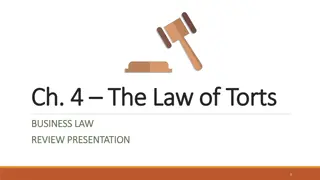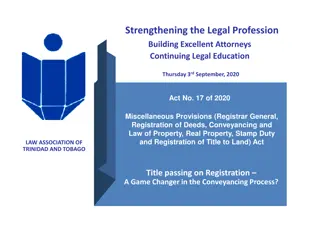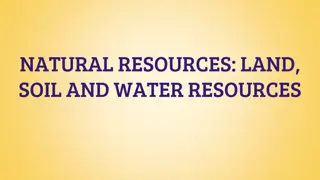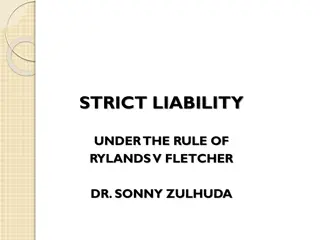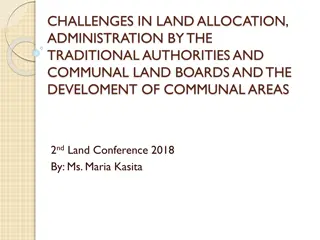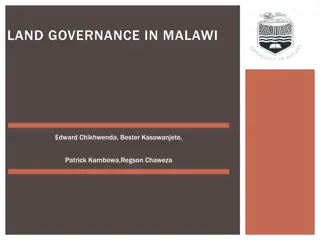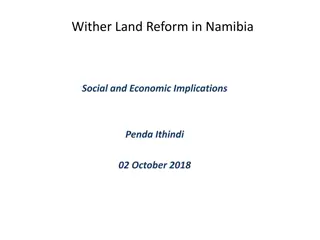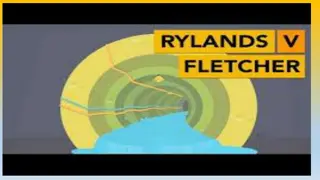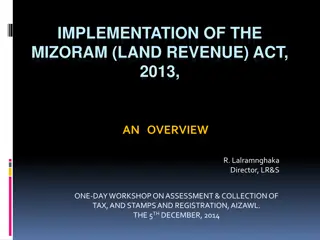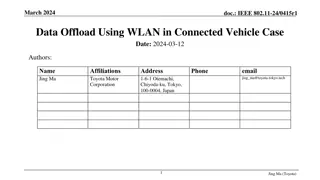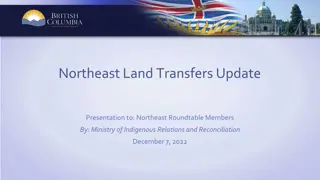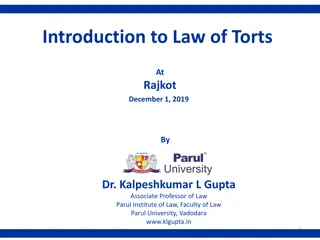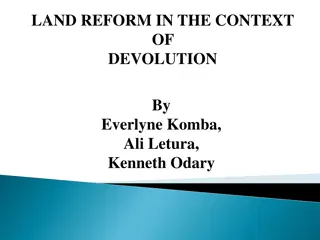Torts Connected to Land: Rylands v. Fletcher
In the case of Rylands v. Fletcher, the House of Lords established a rule holding individuals responsible for damages caused by anything likely to do harm if it escapes their land. This principle has significant implications and has evolved over time with subsequent legal decisions adding nuances to the original ruling. The case highlights the concept that individuals must control and contain substances or elements on their land to prevent harm to neighboring properties.
Download Presentation

Please find below an Image/Link to download the presentation.
The content on the website is provided AS IS for your information and personal use only. It may not be sold, licensed, or shared on other websites without obtaining consent from the author.If you encounter any issues during the download, it is possible that the publisher has removed the file from their server.
You are allowed to download the files provided on this website for personal or commercial use, subject to the condition that they are used lawfully. All files are the property of their respective owners.
The content on the website is provided AS IS for your information and personal use only. It may not be sold, licensed, or shared on other websites without obtaining consent from the author.
E N D
Presentation Transcript
Torts connected to land Rylands v Fletcher
Learning objectives By the end of the session you should be able to: State the Rule in Rylands v Fletcher 1. Explain the essential parts of the Rule 2. Explain the development of the Rule 3. Explain the impact on the Rule of the decision in Cambridge Water Co Ltd v Eastern Counties Leather PLC [1993] 4. Explain the defences to the Rule 5. Explain criticisms of the Rule. 6.
Introduction Facts: Fletcher had a reservoir built on his land. Some time later the reservoir burst and flooded a neighbouring mine run by Ryland. Decision: The House of Lords held that the person who for his own purposes brings on his lands and collects and keeps there anything likely to do mischief if it escapes, must keep it in at his peril, and, if he does not do so, is prima facie answerable for all the damage which is the natural consequence of its escape.
Blackburn J. in the Court of Exchequer quoted by Lord Cairns in Rylands v Fletcher [1868] UKHL 1 We think that the true rule of law is, that the person who, for his own purposes, brings on his land and collects and keeps there anything likely to do mischief if it escapes, must keep it in at his peril; and if he does not do so, is prima facie answerable for all the damage which is the natural consequence of its escape. He can excuse himself by shewing [sic] that the escape was owing to the Plaintiff's default; or, perhaps, that the escape was the consequence of vis major, or the act of God; but as nothing of this sort exists here, it is unnecessary to inquire what excuse would be sufficient. The general rule, as above stated, seems on principle just.
Blackburn J. in the Court of Exchequer quoted by Lord Cairns in Rylands v Fletcher [1868] UKHL 1 The person whose grass or corn is eaten down by the escaping cattle of his neighbour, or whose mine is flooded by the water from his neighbour's reservoir, or whose cellar is invaded by the filth of his neighbour's privy, or whose habitation is made unhealthy by the fumes and noisome vapours of his neighbour's alkali works, is damnified without any fault of his own; and it seems but reasonable and just that the neighbour who has brought something on his own property (which was not naturally there), harmless to others so long as it is confined to his own property, but which he knows will be mischievous if it gets on his neighbour's, should be obliged to make good the damage which ensues if he does not succeed in confining it to his own property. http://www.bailii.org/uk/cases/UKHL/1868/1.html
Activity Use a law dictionary or a multi-media device to find the meaning of the following two terms: prima facie vis major or Act of God [A privy is an outside lavatory.]
Lord Cairns in Rylands v Fletcher [1868] UKHL 1 Lords Cairns (the Lord Chancellor) added that the use of land must be non- natural. He suggested that if water had naturally accumulated on or below the surface of the land then liability would not have arisen.
The Rule The essential parts of the rule are*: Something must have been collected and kept on land 1. The use of the land must be non-natural 2. The thing brought onto the land must be likely to do mischief if it escaped 3. The thing brought onto land must have escaped and caused damage. 4. *Some of these essential parts have been modified, refined and added to by precedent over the years.
The Development of the Rule Although the main principles of the rule have remained, precedent has adapted the rule in a number of ways. In particular, the courts have examined important issues such as: Does the thing collected and kept have to escape itself? 1. What is the meaning of non-natural use of land? 2. To what extend must the thing be likely to cause mischief? 3. Is foreseeability of harm needed? 4.
The Thing Collected and Kept The thing collected and kept on land need not be the thing that escapes. Something collected and kept on land that causes something else to escape can lead to liability. In Miles v Forest Granite Co (Leicestershire) Ltd (1918) explosives kept on land were detonated to break up some rocks. Some of the rocks were forced into the air and escaped the defendant s property and injured the claimant. The explosives caused the rocks to escape the property. The defendant was held to be liable.
Non-Natural Use: Rickards v Lothian [1913] In Rickards v Lothian [1913] water had escaped from an overflow pipe connected to a washbasin where the tap had been left running and the washbasin s waste pipe had been blocked by an unknown person. The Judicial Committee of the Privy Council held that the water from the overflow pipe, did not involve the non-natural use of land. It was also accepted that damage was caused by a third party (i.e. the person who deliberately turned the tap on and blocked the wastepipe).
Non-Natural Use: Rickards v Lothian [1913] Lord Moulton: The provision of a proper supply of water to the various parts of a house is not only reasonable but has become, in accordance with modern sanitary views, an almost necessary feature of town life. It is recognised as being so desirable in the interests of the community that in some form or other it is usually made obligatory in civilized countries. Such a supply cannot be installed without causing some concurrent danger of leakage or overflow. It would be unreasonable for the law to regard those who instal or maintain such a system of supply as doing so at their own peril. with an absolute liability for any damage resulting from its presence even when there has been no negligence. http://www.bailii.org/cgi- bin/format.cgi?doc=/uk/cases/UKPC/1913/1.html&query=(Ric kards)
Question Why was the final appeal in Rickards v Lothian heard by the Judicial Committee of the Privy Council and not the House of Lords?
Question Why was the final appeal in Rickards v Lothian heard by the Judicial Committee of the Privy Council and not the House of Lords? Answer: it was an Australian case and at that time the Judicial Committee of the Privy Council acted as the final court of appeal for Australia.
Escape: Read v J Lyons & Co Ltd [1947] In Read v J Lyons & Co [1947] some explosives detonated in a munitions factory killing one person and injuring others. There was no evidence of negligence and the case was decided using the Rule in Rylands v Fletcher. It was held by the House of Lords that no liability arose because the persons injured were on the premises and there was no escape from the factory.
Non-natural Use: Read v J Lyons & Co Ltd[1947] This case is also important because Lord Porter in the House of Lords stated that, in deciding whether something was being used in a non-natural way, all circumstances must be considered. Lord Porter: as to whether the particular object can be dangerous or the particular use can be non-natural, and in deciding this question I think that all the circumstances of the time and place and practice of mankind must be taken into consideration, so that what might be regarded as dangerous or non-natural may vary according to those circumstances. http://www.bailii.org/uk/cases/UKHL/1946/2.html
Non-natural Use and Likelihood of Mischief: Transco PLC v Stockport Metropolitan Borough Council [2004] A waterpipe took water to a block of flats owned by the council. Unknown to anyone, the pipe had failed and water was escaping. This water caused an embankment to collapse and leave a gas main exposed and unsupported. The gas company took the council to court to recover the cost of repairing the gas main. It was accepted by the House of Lords that the council had not been negligent. The case was decided using the rule in Rylands v Fletcher. The House of Lords decided in favour of the Council because the supply of water through the pipes was normal and did not create any special hazard.
Non-natural Use and Likelihood of Mischief: Transco PLC v Stockport Metropolitan Borough Council [2004] Lord Bingham: It is of course true that water in quantity is almost always capable of causing damage if it escapes. But the piping of a water supply from the mains to the storage tanks in the block was a routine function which would not have struck anyone as raising any special hazard. In truth, the council did not accumulate any water, it merely arranged a supply adequate to meet the residents' needs. The situation cannot stand comparison with the making by Mr Rylands of a substantial reservoir. Nor can the use by the council of its land be seen as in any way extraordinary or unusual. It was entirely normal and routine. https://www.publications.parliament.uk/pa/ld200203/ldj udgmt/jd031119/trans-1.htm
Non-natural Use and Likelihood of Mischief: Transco PLC v Stockport Metropolitan Borough Council [2004] Lord Hoffman: One cannot simply assume that the larger the pipe, the greater the risk of fracture or the greater the quantity of water likely to be discharged. I agree that the criterion of exceptional risk must be taken seriously and creates a high threshold for a claimant to surmount I think that the risk of damage to property caused by leaking water is one against which most people can and do commonly insure. This is, as I have said, particularly true of Transco, which can be expected to have insured against any form of damage to its pipe https://www.publications.parliament.uk/pa/ld200203/ldjudgmt/jd03 1119/trans-1.htm
Non-Natural Use and Foreseeability of Harm: Cambridge Water Co Ltd v Eastern Counties Leather PLC [1994] The Cambridge Water Company provided water to Cambridge. In 1976, they purchased a borehole. In 1980, a European Directive was issued which controlled the presence of PCE (a chemical) in water. The borehole was found to be contaminated with PCE that had come from a tannery owned by Eastern Counties Leather. The contamination was caused by occasional small spillages which eventually soaked through a concrete floor until eventually entering an underground water supply.
Non-Natural Use: Cambridge Water Co Ltd v Eastern Counties Leather PLC [1994] The House of Lords accepted that the storage of PCE by the defendants was a non-natural use of the land.
Non-natural Use: Cambridge Water Co v Eastern Counties Leather PLC [1994] Lord Goff: I feel bound to say that the storage of substantial quantities of chemicals on industrial premises should be regarded as an almost classic case of non-natural use; and I find it very difficult to think that it should be thought objectionable to impose strict liability for damage caused in the event of their escape. http://www.bailii.org/cgi- bin/format.cgi?doc=/uk/cases/UKHL/1993/12.html&query=(cambridge)+AND+(water )+AND+(co)
Foreseeability of Harm: Cambridge Water Co Ltd v Eastern Counties Leather PLC [1994] The House of Lords decided that the claimants needed to show that the defendant should have foreseen the potential contamination of the water supply. It was held that they could not have foreseen this because at the time of the spillages, the reasonable factory supervisor would have expected any spillage to evaporate rapidly in the air and would not have been expected it to seep through the floor of the building into the soil below. This type of foreseeability was established in Wagon Mound (No 1).
Foreseeability of Harm: Cambridge Water Co Ltd v Eastern Counties Leather PLC [1993] Lord Goff: foreseeability of damage of the relevant type should be regarded as a prerequisite of liability in damages under the rule . Please note that Lord Goff does not state foreseeability of damage but foreseeability of the type of damage.
Understanding the Rule in Rylands v Fletcher Activity To fully understand the Rule in Rylands v Fletcher you should read the House of Lords judgement in Transco PLC v Stockport Metropolitan Borough Council [2004]. Five Law Lords explored the development of the rule. Their reasoning and insights can help you prepare for your examination. Here is the link: https://www.publications.parliament.uk/pa/ld200203/ldjudgm t/jd031119/trans-1.htm
Defences: Rylands v Fletcher Possible defences that can be used in Rylands v Fletcher include: Consent Vis major or an Act of God Act of a stranger Statutory authority Contributory negligence
Defences: Rylands v Fletcher Using a textbook or multimedia device research the following cases or statute law: Consent: Peters v Prince of Wales Theatre [1943] Vis major or an Act of God: Nichols v Marsland (1876) Act of a stranger: Perry v Kendrick's Transport Ltd [1956] http://www.bailii.org/ew/cases/EWCA/Civ/1955/5.html Statutory authority: Charing Cross Electric Supply Co v Hydraulic Power Co [1914] Contributory negligence: Law Reform (Contributory Negligence) Act 1945 s1(1) http://www.legislation.gov.uk/ukpga/Geo6/8-9/28/section/1
The Rule in Rylands v Fletcher: A Review The rule was decided at a time when there was growing public concern over bursting reservoir dams which was damaging property. Australia no longer follows the rule: Burnie Port Authority v General Jones Pty Limited [1994] http://www.austlii.edu.au/au/cases/cth/HCA/1994/13.html The rule is not followed in Scotland: RHM Bakeries (Scotland) Ltd v Strathclyde Regional Council [1985] http://www.bailii.org/cgi- bin/format.cgi?doc=/uk/cases/UKHL/1985/1985_SC_HL_17.html&query=(RHM)+AND+(Bakeries)+AND+(v)+AND+(Strathclyde)+AND+(Regional)+ AND+(Council) In English and Welsh law it is increasingly being seen as part of the tort of nuisance rather than a separate tort itself.
The Rule in Rylands v Fletcher: What criticisms of the Rule in Rylands v Fletcher can you think of? [Hint: It is a rule of strict liability]


